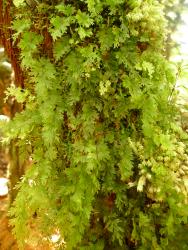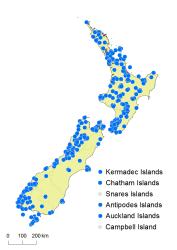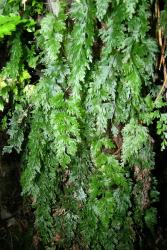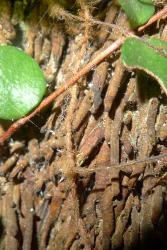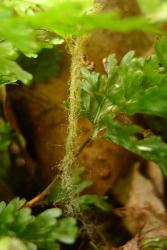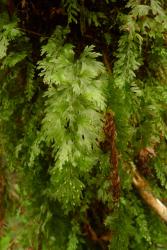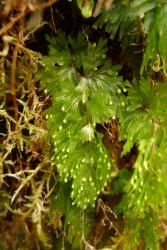- ≡ Mecodium flabellatum (Labill.) Copel., Philipp. J. Sci. 67: 21 (1938)
- = Hymenophyllum nitens R.Br., Prodr. Fl. Nov. Holland. 159 (1810)
Epiphytic, terrestrial or rupestral ferns. Rhizomes long-creeping, 0.25–0.75 mm diameter, bearing abundant fine yellow-brown hairs up to 3 mm long. Fronds 25–390 mm long. Stipes 5–165 mm long, red-brown, not winged, bearing dense yellow-brown hairs near junction with rhizome, more scattered distally. Laminae 3–4-pinnatifid or with the primary pinnae stalked, ovate or narrowly ovate or elliptic or narrowly elliptic, 20–290 mm long, 13–65 mm wide, pale or yellow-green, membranous, with scattered yellow-brown hairs on costae. Rachises narrowly winged in distal half, red-brown or sometimes green distally, bearing fine yellow hairs clustered more densely at pinna junctions; rachis wings planate. Primary pinnae in 3–15 pairs, overlapping, winged for most of their length; distal portion of primary pinnae strongly incurved acroscopically; distal primary pinnae narrowly elliptic or narrowly ovate or ovate, adnate; proximal primary pinnae flabellate or ovate, usually stalked; the longest primary pinnae from the middle to the base, 9–63 mm long, 6–45 mm wide. Secondary pinnae arising both acroscopically and basiscopically, overlapping, winged throughout, adnate; elliptic or narrowly elliptic or narrowly obovate on distal primary pinnae, ovate or elliptic or narrowly elliptic on proximal primary pinnae; the longest secondary pinnae 9–22 mm long, 3–9 mm wide. Ultimate lamina segments oblong, up to 3 mm long, 0.7–1.5 mm wide; apices acute or obtuse or truncate; margins entire, lacking a distinct border; distal segments on primary pinnae slightly curved towards frond apex. Sori borne on acroscopic and basiscopic segments mostly at the distal ends of the pinnae, solitary on each segment, many on each primary pinna, adnate or partially immersed in lamina; indusia bivalvate; indusial flaps ovate or elliptic or almost orbicular, 0.75–1.5 mm long, apices obtuse, margins entire; receptacles included within indusial flaps.
Hymenophyllum flabellatum is recognised by its pale or yellow-green fronds, flabellate pinnae, entire lamina margins and tufts of long yellow-brown hairs on the rhizome and stipes. When young, or growing on tree fern trunks, the species has small fronds with markedly fan-shaped pinnae which tend to curl upwards, away from the plane of the frond. Older fronds, or those growing on wet banks or rock overhangs, are much longer, with more drawn-out and dissected pinnae.
The species is closely related to H. rufescens but grows at lower altitudes, and can usually be distinguished by its larger and almost glabrous laminae. Intermediate forms are sometimes found in areas where the two species meet, but whether these are hybrids is unclear. DNA sequencing suggests that the two species are distinct (Perrie et al. 2016).
North Island: Northland, Auckland, Volcanic Plateau, Gisborne, Taranaki, Southern North Island.
South Island: Western Nelson, Sounds-Nelson, Marlborough, Westland, Canterbury, Otago, Southland, Fiordland.
Kermadec Islands, Chatham Islands, Solander Island, Stewart Island, Antipodes Islands, Auckland Islands.
Altitudinal range: 10–1150 m.
Hymenophyllum flabellatum is widely distributed in the New Zealand region from the Kermadec Islands to the Chatham and Auckland Islands. It occurs in lowland and montane areas throughout the North Island, ranging from near sea level to 1050 m at Lake Waikaremoana and on Mt Honokawa, Gisborne. In the South Island it is found most commonly west of the main divide, but also occurs in scattered populations in coastal and inland eastern areas. It is apparently absent from much of inland Otago and south Canterbury. It grows from near sea level to 1150 m on Mt Perry on the Heaphy Track.
Also Australia (Queensland, New South Wales, Victoria, Tasmania), Vanuatu, Fiji, Samoa, Society Islands, Marquesas Islands.
Occurs under kauri, podocarp, beech, broadleaved forest and Olearia colensoi scrub, usually as an epiphyte but also hanging from rotten logs, fallen trunks and steep banks, at the base of trunks, and on boulders and wet rock faces. It has been recorded growing epiphytically on Cyathea dealbata, C. smithii, Dicksonia fibrosa, D. squarrosa, Beilschmiedia tawa, Libocedrus bidwillii, Melicytus ramiflorus, Metrosideros excelsa, M. kermadecensis, M. robusta, M. umbellata, Weinmannia racemosa, species of Nothofagaceae and hanging from Astelia clumps.
n = 36 (Brownlie 1954).
Plants of Hymenophyllum flabellatum in Australia tend to have larger fronds with more finely divided pinnae and narrower ultimate lamina segments. The pinnae are less obviously flabellate, and the small forms seen in New Zealand with markedly fan-shaped pinnae curling upwards are rare in Australia. The same chromosome number has been reported from populations in both countries (Brownlie 1954; Tindale & Roy 2002). Molecular evidence also suggests that populations in New Zealand and Australia probably belong to the same species, but that material from Fiji and Tahiti ascribed to H. flabellatum clearly belongs to a different species (Perrie et al. 2016).
Tindale (1963) stated that the holotype of H. flabellatum was in FI, noting that Labillardière’s original description in his hand-writing was affixed to the specimen (FI 004176). However, there are also other Labillardière collections in B, GH and P which Tindale did not mention: Nov. Holland. [Australia], Ins. King [King Island], P – Herb. Jussieu No. 1506! (photo WELT E478/6); Nova Hollandia, Labillardière, GH 00021352 (!online); Labillardière, B – Herb. Willd. No. 20230-01 0 (!online; see Bostock & Spokes 1998). We interpret these as separate syntypes. Nevertheless, Tindale’s original statement constitutes effective lectotypification.



